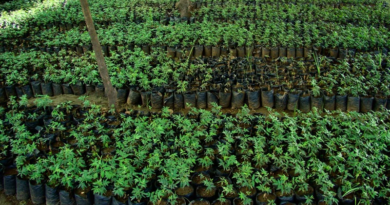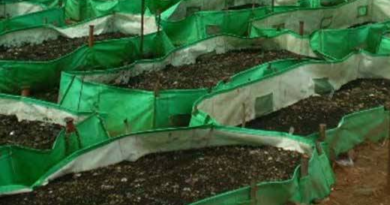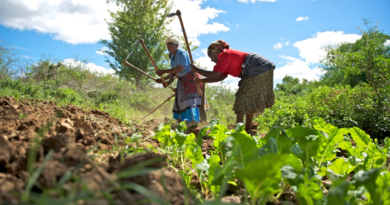Solanaceous Crop Cultivator(6 month course)
Solanaceous Crop Cultivator

Solanaceous Grower Grower: Each person manages to plant a Solanaceous plant in a particular part of the world. Response includes the availability of seeds to market market product in the market Short Description: Solaceaceous Crop Cultivator activity includes the cultivation of a solanaceous plant as a package of recommended practices for a particular agricultural climate, soil type, rain pattern and climatic conditions to achieve genetic diversity. in terms of prices in a competitive market without tragic sales. Your Qualities: A job requires a person to have: The ability to work, be dangerous and must be able to work hard and make decisions about his or her job. One has to deal with the consequences and has to deal with one’s learning and performance. Each person should be able to understand the basic principle of arithmetic and algebraic. We need to be able to access and analyze various opportunities and threats to the weather and markets Solanaceous Crop Cultivator

Seed selection & seedling production Solanaceous Crop Cultivator:
In order to be effective, that person must be able to: PC1. identify the varied and appropriate variety (including hybrid) of PC2-only crops. identify the various vendors / suppliers (including government / departmental agencies) of certified PC3 seeds. buy seeds in the right quantity PC4. find market prices for seeds of solanaceous plants (such as tomatoes, capsicum, etc.) Managing a crèche for growing solanaceous plants To be competent, one must be able to: PC5. indicate the path of the nursery or tray of growing plants PC6. plant seeds at the right depth and in the right spaces for PC7. water the seedling at the right time in the right way PC8. work with agricultural experts to guide you
Organizational Context (Knowledge of the company / organization and its processes):
The user / person at work needs to know and understand: KA1. applicable law, standards, policies, and procedures in the workplace KA2. appropriate health and safety requirements applicable to workplace KA3. your job role and responsibilities and resources about KA4 work. who can request assistance for information related to the operation, clarification and support of KA5. the importance of compliance with health, hygiene, safety and quality standards and the impact of non-compliance on consumer and business KA6. documents and related procedures applicable to the context of the work Solanaceous Crop Cultivator.
Technical Knowledge:
The user / person at work needs to know and understand: KB1. various seed characteristics and their suitability in the KB2 environment. features of the healthy strains of KB3. demand for variety in the KB4 market. the advantages and disadvantages of soil kindergartens or the KB5 tray system. depth and separation of seedlings in the case of soil nursery & tray KB6. features of the appropriate tray (hole size, depth, size, etc.) KB7. use of mesh net net and tunnels net KB8. appropriate temperature, humidity and water content for seedlings to germinate

Core Skills/Generic Skills Solanaceous Crop Cultivator:

The user / person at work needs to know and understand how to do this: SA1. discover and update on the latest varieties of solanaceous plant by reading SA2 newspapers and magazines. should track the recent development of solanaceous plantings by reading brochures, pamphlets and product information sheets Oral communication (listening and speaking skills) The user / person at work needs to know and understand how to do it: SA3. maintain effective working relationships SA4. liaising with others such as farmers, official / affected stakeholders SA5. understanding information shared by senior people and experts B. Practicing Professional Skills A user / employee needs to know and understand how to do it: SB1. make decisions for the affected area of the SB2 function. identify potential problems during operations and take steps to prevent them from following the various procedures included in SB3. decide to earn financial gain Plan and plan The user / person at work needs to know and understand: how to make SB4. plan and organize field processes ranging from land preparation to SB5 crèche management. arrange meetings / exhibitions with agricultural departments whenever the need for Customer Centricity The user / employee needs to know and understand: SB6. participate in the solanaceous SB7 crop / seminar / workshop. to attend and use the SB8 portrayed tour. work with Solanaceous Plant Specialists Solving Problems A user / employee needs to know and understand: SB9. think about the problem, test possible solutions (s) and use the largest / best solution (s) SB10. identify problems quickly and take action to resolve delays Thinking Consideration The user / employee needs to know and understand: SB11. view and store equipment and equipment needed for weed control SB12. monitor and maintain the equipment and equipment required for land preparation and direct planting / sowing. SB13. watch plant transplants or direct planting Important Thinking The user / person at work needs to know and understand that: SB13. use, analyze, and test data collected in the view, Solanaceous Crop Cultivator.
Soil preparation and transplanting in solanaceous crops:

In order to be effective, that person must be able to: PC1. check soil for authorized PC2. adjust the world to get the correct PC3 tilth. prepare the ground with trenches and trenches PC4. apply farm yard compost and fertilizer PC5. pre-irrigation before transplanting Seedling transplantation In order to be effective, the person must be able to: PC6. plant the seedling at the right time, on stage and in the right space
Organizational Context (Knowledge of the company / organization and its processes) Solanaceous Crop Cultivator:
The user / person at work needs to know and understand: KA1. applicable law, standards, policies, and procedures in the workplace KA2. appropriate health and safety requirements applicable to workplace KA3. your job role and responsibilities and resources about KA4 work. who can request assistance for information related to the operation, clarification and support of KA5. the importance of compliance with health, hygiene, safety and quality standards and the impact of non-compliance on consumer and business KA6. documents and related procedures applicable to the context of the work
The user / person at work needs to know and understand: KB1. various soil testing facilities KB2. The level of soil cultivation includes the connectivity link and the appropriate KB3 connectivity equipment. distance between channels and channels KB4. the need for yard compost and fertilizer in the correct quantity of KB5. the right time to plant by taking soil, weather conditions KB6. planting equipment (shovel or trowel) KB7. space between rows and plants KB8. the advantages and disadvantages of crop hybrids and plant species to be overcome with KB9. benefits of crop rotation Solanaceous Crop Cultivator

Core Skills/ Generic Skills:
The user / person at work needs to know and understand how to do this: SA1. discover and update on the latest varieties of solanaceous plant by reading SA2 newspapers and magazines. track the recent development of solanaceous plantings by reading SA3 product brochures, pamphlets and newsletters. read and understand the safety and use of pesticides oral communication (listening and speaking skills) The user / person at work needs to know and understand: SA4. maintain an active SA5 relationship. liaising with other stakeholders such as farmers, official / affected stakeholders SA6. understands information shared by senior people and experts B. Practicing Professional Skills A user / employee needs to know and understand how to do this: SB1. make decisions for the affected area of the SB2 function. identify potential problems during operations and take steps to prevent them from following the various procedures included in SB3. decide on the best practices for SB4 nutrition. decide to earn financial gain Plan and plan The user / person at work needs to know and understand: how to make SB5. plan and coordinate field processes from kindergarten management to SB6 harvest. arrange meetings / exhibitions with agricultural departments whenever required by Customer Centricity The user / employee needs to know and understand that: SB7. participate in the SB8 crop / seminar / workshop. to visit and use the SB9 portable tourism. work with Solanaceous Plant Specialists Solving Problems Each user / individual in the workplace needs to know and understand: SB10. think about the problem, try out the possible solutions (s) and use the biggest / best solution (s) SB11. identify problems quickly and take solutions to resolve delays Analytical Thinking The user / employee needs to know and understand: SB12. inspect and maintain the equipment and equipment required for soil preparation SB13. monitor and maintain the equipment and equipment required for land preparation and direct planting / sowing. SB14. watch plant transplants or direct planting Important Thinking The user / person at work needs to know and understand that: SB15. use, analyze, and evaluate information collected from observation, experience, consultation, or communication, as a guide to thought and action SB16. take his work and learning
Soil nutrient management in vegetable crops Solanaceous Crop Cultivator:
Performance Criteria Macro & soil micronutrients and tests To be effective, a person must be able to: PC1. understand basic and minor nutrients through their PC2 functions. perform a soil test to determine which nutrients and fertilizers are derived from the authorized PC3 laboratory PC3. compile a soil test report Use of organic and chemical fertilizers To be effective, the person must be able to: PC4. select the appropriate fertilizer that includes the compost of the farm yard of its PC5 system. use organic and non-organic fertilizers in the right amount and at the right time PC6. use vermicompost and consult its specialist in use Solanaceous Crop Cultivator
Organizational Context (Knowledge of the company / organization and its processes):
Performance Criteria Macro & soil micronutrients and tests To be effective, a person must be able to: PC1. understand basic and minor nutrients through their PC2 functions. perform a soil test to determine which nutrients and fertilizers are derived from the authorized PC3 laboratory PC3. compile a soil test report Use of organic and chemical fertilizers To be effective, the person must be able to: PC4. select the appropriate fertilizer that includes the compost of the farm yard of its PC5 system. use organic and non-organic fertilizers in the right amount and at the right time PC6. use vermicompost and consult its specialist in use
Technical Knowledge:
The user / person at work needs to know and understand: KB1. elements / sub-components of macro & micro nutrient KB2. performance of each macro & micro KB3 component. advantages and disadvantages of specific macro & micro KB4 elements. incorporate organic and chemical fertilizers based on the KB5 soil test report. use of farm yard manure in the right amount and at the right time (application during initial connection) KB6. information on vermicompost and its operating time KB7. the ratio and timing of fertilizer application that is required according to the time of the vegetable plant KB8. the correct way to apply fertilizer
Core Skills/ Generic Skills:
The user / person at work needs to know and understand how to do this: SA1. discover and update on the latest varieties of organic and chemical fertilizers by reading SA2 newspapers and magazines. should keep abreast of the latest developments in plant nutrient management by reading SA3 brochures, pamphlets and worksheets. read and understand the safety and use of pesticides oral communication (listening and speaking skills) The user / person at work needs to know and understand: SA4. maintain an active SA5 relationship. liaising with other stakeholders such as farmers, official / affected stakeholders SA6. understands information shared by senior people and experts B. Practicing Professional Skills A user / employee needs to know and understand how to do this: SB1. make decisions for the affected area of the SB2 function. identify potential problems during operations and take steps to prevent them from following the various procedures included in SB3. decide to earn money Plan and organize User / employee needs to know and understand: SB4. plan and configure field processes that initiate SB5 element management. farm and fertilizer procurement system in bulk and on time SB6. arrange meetings / demonstrations with the Department of Agriculture whenever the Customer Centricity is required. The user / employee must know and understand that: SB7. participate in the SB8 vegetable / vegetable / workshop exhibition. to visit and use the SB9 portable tourism. work with vegetable and vegetable specialists Problem Solving The user / employee needs to know and understand: SB10. think about the problem, try out the possible solutions (s) and use the biggest / best solution (s) SB11. identify problems quickly and take solutions to resolve delays Analytical Thinking The user / employee needs to know and understand: SB12. view and store the equipment and equipment needed for land fertility management, Critical Thinking The user / person on the job needs to know and understand: SB13. use, analyze, and evaluate information collected from observation, experience, consultation, or communication, as a guide for thought and action SB14. take his work and learning Solanaceous Crop Cultivator

Weed control and management in vegetable crops Solanaceous Crop Cultivator:
In order to be effective, that person must be able to: PC1. identify the weed species in the PC2 plant. keep growing records and share it with PC3 experts. describe the symptoms and get the input of vegetable specialists in weed management Weed management in different stages of the crop cycle In order to do well, one must know: PC4. control weeds during cultivation PC5. perform a timely weed removal process to avoid damage to plant PC6. use bio herbicides to control weeds wherever PC7 is possible. use new and innovative methods of soil partition and pasteurization PC8. use mechanical weed control equipment where available and operational
Organizational Context (Knowledge of the company / organization and its processes):
The user / person at work needs to know and understand: KA1. applicable law, standards, policies, and procedures in the workplace KA2. appropriate health and safety requirements applicable to workplace KA3. your job role and responsibilities and resources about KA4 work. who can request assistance for information related to the operation, clarification and support of KA5. the importance of compliance with health, hygiene, safety and quality standards and the impact of non-compliance on consumer and business KA6. documents and related procedures applicable to the context of the work
Technical Knowledge:
The user / person at work needs to know and understand: KB1. different types of Weeds (wide range, weed etc.) KB2. weed species and their control mechanisms KB3. pros and cons of herbicide & mechanical weed control KB4. critical stages of weed control (initial weed removal period) KB5. the use of various weed control methods such as mulch plastic KB6. processes involved in soil partition and food reduction Solanaceous Crop Cultivator
Core Skills/ Generic Skills:
The user / person at work needs to know and understand how to do this: SA1. get the details and update the latest weed varieties by reading SA2 newspapers and magazines. follow the latest developments in weed management by reading the newspaper, brochures, SA3 magazines. read and understand the safety and use of pesticides / herbicides Oral communication (Listening and Speaking skills) The user / person at work needs to know and understand how to do this: SA4. maintain an active SA5 relationship. liaising with other stakeholders such as farmers, official / affected stakeholders SA6. understands information shared by senior people and experts B. Practicing Professional Skills A user / employee needs to know and understand how to do this: SB1. make decisions for the affected area of the SB2 function. identify potential problems during operations and take steps to prevent them from following the various procedures included in SB3. to make a profit decision and avoid yield loss Plan and Plan User / employee needs to know and understand: SB4. arrange meetings / demonstrations with the Departments of Agriculture whenever the need for Customer Centricity The user / employee needs to know and understand how to do this: SB5. participate in the crop show / conference / workshop SB6. attend SB7 retraining training. make and use SB8 exposure visits. work with botanists Troubleshooting Troubleshooting The user / person at work needs to know and understand how to do this: SB9. think about the problem, explore possible solutions and use the biggest / best solution (s) SB10. identify problems quickly and take solutions to delay delays Analytical Thinking The user / person at work needs to know and understand that in order to: SB11. View and store the materials and equipment needed for weed management SB12.watch and maintain the equipment and equipment needed for land preparation and direct planting / planting. SB13.watch plant transplant or direct planting Important Thinking The user / person at work needs to know and understand: SB14. use, analyze, and evaluate information collected from observation, experience, consultation, or communication, as a guide for thought and practice SB15. take his work and learning Solanaceous Crop Cultivator
Guidelines for Assessment:
The terms of reference for each Qualification Package shall be determined by the Technical Technology Council. Criteria for each operation (PC) will be awarded marks according to its importance to the NOS. SSC will also place a number of Theory and Practical Skills marks on each PC. 2. The partial examination of the Solanaceous Crop Cultivatoropinion will be based on the information bank of the questions created by the SSC. 3. All mandatory NOS will be tested, and where appropriate, in the selected NOS / NOS / NOS collection. 4. Each assessment agency will create a unique questionnaire on the theory section for each student in each assessment / training center (according to the assessment process below). 4. Each assessment agency will create a separate competency test for each student in each assessment / training center based on this process. 5. To pass the Qualification Pack, every trainee must obtain a minimum mark of 70% of the total mark to clear the exam. 6. In the event of failure, the trainee may seek re-examination in the Qualification Pack Solanaceous Crop Cultivator.




